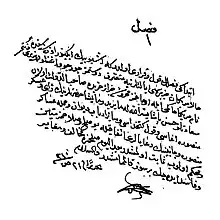 Treaty of safety and peace between Hassan Pasha Dey of Algeria and George Washington, regarding the freedom of ships and not allowing the sale of Algerian ships to countries that are at war with America, September 05, 1795 | |
| Signed | September 5, 1795 |
|---|---|
| Parties |
|
A Treaty of Peace and Friendship was signed between the United States and the Regency of Algiers on 5 September 1795.
Background

Following the independence of the United States (1776), American merchant ships no longer benefit from the protection of Royal Navy ships, which is a problem for them in the Mediterranean. American ships were then found in 1785 attacked by the privateers of what the West then called Barbarism, corresponding to the Ottoman provinces of the Maghreb (modern Tunisia, Libya and Algeria). The United States Senate decided to propose a "Treaty of Peace and Friendship With the States of Barbaria", an amendment to which was initialled on 5 September 1795 in Algiers and again on 3 January 1797.
The treaty was unanimously ratified by the United States Senate in early June and signed by John Adams, the second American president, and appeared in what was the then US Official Gazette, the Philadelphia Gazette, on June 17, 1797.
Tribute

The United States federal government was to be annually charged the equivalent of 12,000 Algerian sequins[2] (i.e US dollars 21,600, 64,800 gold francs) to protect its trade from piracy. This toll was served uninterrupted until 1810, and payment was suspended in 1811,[3] and it was also to provide a 32-gun frigate and three other[4] ships:
- Berge Crescent (renamed in Algiers El Merikana for The American) of 32 guns, designer Josiah Fox, launched 29/06/1797 at Portsmouth, 122 feet – 32 feet plus 10 feet 2 inches;[5]
- 22-gun brig Hassan Bashaw/Hassan Pasha, designer Samuel Humphreys, launched in 1798 in Philadelphia, 275 long tone, 97 feet or 93 feet 2 inches plus 27 feet plus 11 feet 6 inches[6]
- 20-gun schoonk Skjoldebrand, designer Benjamin Hutton, built at Philadelphia, 77 feet 6 inches plus 23 feet plus 10 feet 6 inches;
- 18-gun Lelah Eisha schooner, designer Samuel Bowers.
The treaty was purchased by the United States at an estimated cost of USD 992,463.25 by the United States Department of the Treasury.[2]
Continuation
In 1801, Yusuf Karamanli, the pasha of Tripoli, demanded that the United States pay an increase in the United States' price. This demand was repulsed and the pasha with his allies from the Barbary Coast declared war in the United States on 14 May 1801.
US President Thomas Jefferson then sent United States Navy ships shelling the cities of Tripoli and Algiers and renegotiated the treaty in 1805.
In April 2006, US Secretary of State Condoleezza Rice offered Washington a copy of the original of the treaty to Algerian Foreign Minister Mohammed Bedjaoui[7]
References
- ↑ Treaties and other international acts of the United States of America, edited by Hunter Miller. (Washington, D.C. : U.S. G.P.O., 1931–1948.) p. 276
- 1 2 "The Barbary Treaties 1786–1816 Treaty of Peace and Amity, Signed at Algiers September 5, 1795“ (archive) on Yale Law School, 2008 (accessed 31 October 2013)
- ↑ Albert Devoulx, Le Raïs Hamidou: Biographical note on the most famous Algerian privateer of the 13th century AH according to authentic and mostly unpublished documents, Typography Adolphe Jourdan, Algiers, 1859 (read online archive), XIII. — La mort du Raïs Hamidou.
- ↑ Paul H. Silverstone, The Sailing Navy 1775–1854, 2006, 99 p. (ISBN 0-415-97872-6, read online archive), p. 30
- ↑ Michael J. Crawford and Christine F. Hughes, The Establishment of the Navy, 1787–1801: publisher: Naval Historical Center, 1995 (read online archive)
- ↑ Gail E. Farr and Brett F. Bostwick, John Lenthall Naval Architect: A Guide to Plans and Drawings of American Naval and Merchant Vessels 1790–1874 Philadelphia Maritime Museum, 19911991, 52 pp. (ISBN 0-913346-19-5, read online archived), p.14
- ↑ Treaties of peace and friendship between the State of Algiers and the United States of America (1795, 1815 and 1816) archive